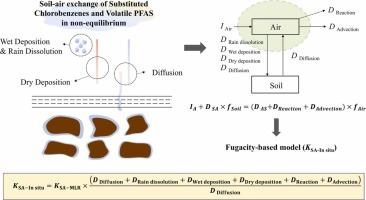Soil-Air Exchange of Substituted Chlorobenzenes and Volatile PFAS at Contaminated Site: Impact of Environmental Factors and Development of a Fugacity-Based Model
IF 11.3
1区 环境科学与生态学
Q1 ENGINEERING, ENVIRONMENTAL
引用次数: 0
Abstract
Substituted chlorobenzenes and volatile per- and polyfluoroalkyl substances (PFAS) are significant environmental contaminants that impact soil and air ecosystems. This study investigates the soil-air exchange behavior of these compounds and develops models to predict their exchange under varying environmental conditions. The soil-air partitioning coefficient (KSA) was determined for substituted chlorobenzenes using a solid-phase fugacity meter under different temperatures, relative humidity, and soil organic carbon contents. The results indicate that temperature, relative humidity, and soil organic carbon content significantly influence KSA values. Higher temperatures and humidity increase the volatilization of substituted chlorobenzenes from soil to air, while higher organic carbon content reduces volatility. A multiple linear regression (KSA-MLR) model was developed to predict KSA values, showing high accuracy (adjusted R² = 0.956). Additionally, a fugacity-based model (KSA-In situ) was established to quantify the actual soil-air exchange of these compounds at contaminated sites or laboratory microenvironments. The KSA-In situ model demonstrated better accuracy than the KSA-MLR model in non-equilibrium conditions. This study provides insight into the soil-air behavior and fate of substituted chlorobenzenes and volatile PFAS at contaminated sites. It also offers a robust predictive framework for quantifying their soil-air exchange under varying environmental conditions. This enhances our understanding of their transport mechanisms and supports more effective environmental management and risk assessment.

污染场地中取代氯苯和挥发性PFAS的土壤-空气交换:环境因素的影响及基于逸度模型的建立
取代氯苯和挥发性全氟烷基和多氟烷基物质(PFAS)是影响土壤和空气生态系统的重要环境污染物。本研究调查了这些化合物的土壤-空气交换行为,并建立了模型来预测它们在不同环境条件下的交换。采用固相逸度法测定了不同温度、相对湿度和土壤有机碳含量下取代氯苯的土壤-空气分配系数(KSA)。结果表明,温度、相对湿度和土壤有机碳含量对KSA值有显著影响。较高的温度和湿度增加了取代氯苯从土壤到空气的挥发性,而较高的有机碳含量则减少了挥发性。建立多元线性回归(KSA- mlr)模型预测KSA值,具有较高的准确性(调整后R²= 0.956)。此外,建立了基于逸度的模型(KSA-In - situ)来量化这些化合物在污染场地或实验室微环境中的实际土壤-空气交换。在非平衡条件下,ksa原位模型比KSA-MLR模型具有更好的精度。本研究提供了对污染场地中取代氯苯和挥发性PFAS的土壤-空气行为和命运的深入了解。它还为量化不同环境条件下的土壤-空气交换提供了一个强大的预测框架。这加强了我们对其运输机制的理解,并支持更有效的环境管理和风险评估。
本文章由计算机程序翻译,如有差异,请以英文原文为准。
求助全文
约1分钟内获得全文
求助全文
来源期刊

Journal of Hazardous Materials
工程技术-工程:环境
CiteScore
25.40
自引率
5.90%
发文量
3059
审稿时长
58 days
期刊介绍:
The Journal of Hazardous Materials serves as a global platform for promoting cutting-edge research in the field of Environmental Science and Engineering. Our publication features a wide range of articles, including full-length research papers, review articles, and perspectives, with the aim of enhancing our understanding of the dangers and risks associated with various materials concerning public health and the environment. It is important to note that the term "environmental contaminants" refers specifically to substances that pose hazardous effects through contamination, while excluding those that do not have such impacts on the environment or human health. Moreover, we emphasize the distinction between wastes and hazardous materials in order to provide further clarity on the scope of the journal. We have a keen interest in exploring specific compounds and microbial agents that have adverse effects on the environment.
 求助内容:
求助内容: 应助结果提醒方式:
应助结果提醒方式:


